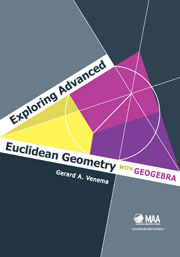Book contents
- Frontmatter
- Preface
- Contents
- 0 A Quick Review of Elementary Euclidean Geometry
- 1 The Elements of GeoGebra
- 2 The Classical Triangle Centers
- 3 Advanced Techniques in GeoGebra
- 4 Circumscribed, Inscribed, and Escribed Circles
- 5 The Medial and Orthic Triangles
- 6 Quadrilaterals
- 7 The Nine-Point Circle
- 8 Ceva's Theorem
- 9 The Theorem of Menelaus
- 10 Circles and Lines
- 11 Applications of the Theorem of Menelaus
- 12 Additional Topics in Triangle Geometry
- 13 Inversions in Circles
- 14 The Poincaré Disk
- References
- Index
- About the Author
0 - A Quick Review of Elementary Euclidean Geometry
- Frontmatter
- Preface
- Contents
- 0 A Quick Review of Elementary Euclidean Geometry
- 1 The Elements of GeoGebra
- 2 The Classical Triangle Centers
- 3 Advanced Techniques in GeoGebra
- 4 Circumscribed, Inscribed, and Escribed Circles
- 5 The Medial and Orthic Triangles
- 6 Quadrilaterals
- 7 The Nine-Point Circle
- 8 Ceva's Theorem
- 9 The Theorem of Menelaus
- 10 Circles and Lines
- 11 Applications of the Theorem of Menelaus
- 12 Additional Topics in Triangle Geometry
- 13 Inversions in Circles
- 14 The Poincaré Disk
- References
- Index
- About the Author
Summary
This preliminary chapter reviews basic results from elementary Euclidean geometry that will be needed in the remainder of the book. It assumes that readers have already studied elementary Euclidean geometry; the purpose of the chapter is to clarify which results will be used later and to introduce consistent notation. Readers who are using this book as a supplement to a course in the foundations of geometry can probably omit most of the chapter and simply refer to it as needed for a summary of the notation and terminology that are used in the remainder of the book.
The theorems in this chapter are to be assumed without proof; the entire chapter may be viewed as an extended set of axioms for the subject of advanced Euclidean geometry. The results in the exercises should be proved using the theorems stated in the chapter. All the exercises in the chapter are theorems that will be needed later.
We will usually refer directly to Euclid's Elements when we cite a result from elementary Euclidean geometry. Several current editions of the Elements are listed in the bibliography (see [4], [5], or [8]). The Elements are in the public domain and are freely available on the world wide web as well. Euclid's propositions are referenced by book number followed by the proposition number within that book. Thus, for example, Proposition III.36 refers to the 36th proposition in Book III of the Elements.
- Type
- Chapter
- Information
- Exploring Advanced Euclidean Geometry with GeoGebra , pp. 1 - 12Publisher: Mathematical Association of AmericaPrint publication year: 2013

